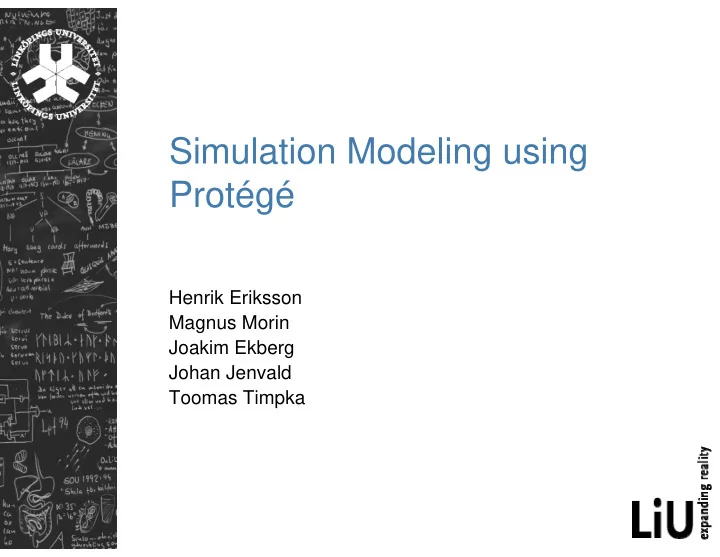

Simulation Modeling using Protégé Henrik Eriksson Magnus Morin Joakim Ekberg Johan Jenvald Toomas Timpka
Models of community structures Geographical � Logistical � Social � Cultural � Mixing-group approach � People get infected where they meet other people �
Number of secondary cases (Ro) In most cases, we get no 600 outbreak 500 Number of instances (n=1000) Results from 1000 400 simulation runs: Frequency of secondary cases 300 200 Super 100 spreaders 0 0 5 10 15 20 25 30 35 Number of secondary cases
Simulator requirements Fast turn-around time (<24h) � Updated simulation as more information become available � Transparent, user-friendly models � Pluggable models � Interchangeable disease model � Alternative community models (e.g., actual and randomized) � Scalable computational environment � Visualization �
Pandemic modeling and simulation
Simulation environment—architectural layers
Simulation Architecture Protégé Scenario developer Protégé extensions XML-based Simulation simulation Results engine Report parameters (Computational generator Simulation model environment) (scenario ontology)
Ontology-based simulation model Simulation model
Editing of community definition
Protégé tab extension for scenario editing Submodels used in the scenario
Protégé tab for simulation job specification Job parameters List of scenarios to simulate
Simulation engine and computational environment Requirement � Interactive simulation � Dynamic scaling � Problem � Supercomputers are fast, but using them takes too long time � (job queues) Solution � Separation of modeling and execution environments � Protégé (Java) versus custom simulator (C++) � Condor � Pool of machines (basic resource) � Rent additional machines as needed (Amazon EC2) � Web application for managing simulation nodes and � simulation jobs Google Web Toolkit (GWT) �
Computational environment The Condor platform � System for managing clusters of dedicated compute nodes � Workload management system for compute-intensive jobs � Batch system with a job queueing mechanism, scheduling, resource � monitoring and management, etc. Matching of resource requests (jobs) with resource offers � (machines) Developed by University of Wisconsin-Madison (UW-Madison) � Condor components/actors � Condor manager � Collects information about the pool of machines � Manages the job queue � Dispatches tasks to workers � Condor workers � Machines that execute tasks � Storage system � Storage of input and output data �
Computational environment (cont.) Tasks parallelized at the level of � alternative scenarios � different randomized communities �
Computational environment (cont.)
Multiple Condor pool environment
Web interface for Amazon EC2 management Bootable images (with Condor) Running machines
Two jobs running Condor job queue
Simulation results New and completed jobs Results overview
Discussion and Conclusion Summary � Simulation of influenza outbreaks benefits from a clear separation of modeling � and implementation Ontologies provide a suitable representation scheme for such epidemiological � models Ontology management during a factual pandemic outbreak is supported by � the maintenance of a scenario library with a collection of instances representing the scenarios Implementation � Modeling and simulation environment based on ontology models in Protégé � Corresponding cloud-based execution environment � Continued work � Improved flexibility of simulator engine � Submitting simulation jobs from Protégé � Controlling Amazon EC2 and Condor from Protégé � Visualization of results �
Recommend
More recommend